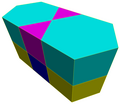Bob
Have a question related to this hub?
Alice
Got something to say related to this hub?
Share it here.
| Hexagon prism | |
|---|---|
 | |
| Type | prism, parallelohedron |
| Symmetry group | prismatic symmetry of order 24 |
| Dual polyhedron | hexagonal bipyramid |

In geometry, the hexagonal prism is a prism with hexagonal base. Prisms are polyhedrons; this polyhedron has 8 faces, 18 edges, and 12 vertices.[1]
If faces are all regular, the hexagonal prism is a semiregular polyhedron—more generally, a uniform polyhedron—and the fourth in an infinite set of prisms formed by square sides and two regular polygon caps. It can be seen as a truncated hexagonal hosohedron, represented by Schläfli symbol t{2,6}. Alternately it can be seen as the Cartesian product of a regular hexagon and a line segment, and represented by the product {6}×{}. The dual of a hexagonal prism is a hexagonal bipyramid.
The symmetry group of a right hexagonal prism is prismatic symmetry of order 24, consisting of rotation around an axis passing through the regular hexagon bases' center, and reflection across a horizontal plane.[2]
As in most prisms, the volume is found by taking the area of the base, with a side length of , and multiplying it by the height , giving the formula:[3] and its surface area is by summing the area of two regular hexagonal bases and the lateral faces of six squares:

The hexagonal prism is one of the parallelohedron, a polyhedral class that can be translated without rotations in Euclidean space, producing honeycombs; this class was discovered by Evgraf Fedorov in accordance with his studies of crystallography systems. The hexagonal prism is generated from four line segments, three of them parallel to a common plane and the fourth not.[4] Its most symmetric form is the right prism over a regular hexagon, forming the hexagonal prismatic honeycomb.[5]
The hexagonal prism also exists as cells of four prismatic uniform convex honeycombs in 3 dimensions:
| Triangular-hexagonal prismatic honeycomb |
Snub triangular-hexagonal prismatic honeycomb |
Rhombitriangular-hexagonal prismatic honeycomb |

|

|

|
It also exists as cells of a number of four-dimensional uniform 4-polytopes, including: